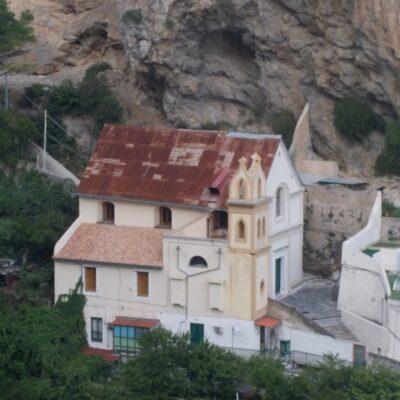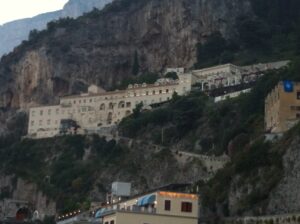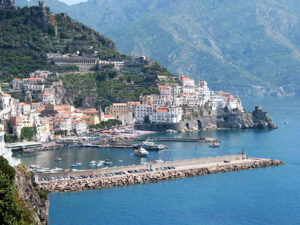MUNICIPALITY: Atrani
NAME: Church of the Madonna del Carmine
LOCATION: Via Carmine
DESCRIPTION: The church, home to a historic Atrani congregation, was built in 1604 by Scipione Crepella and Giambattista Vollaro; it is a single-nave structure with two chapels on each side and a lunetted barrel-vaulted roof.
Over the entrance, an ancient organ, with a wooden balcony, recalls the devotion of an Atranese family to this church.
The decoration in the upper part of the side walls is very intricate and features “grotesque” motifs and angels on the vault; a huge fresco occupies all the light of the high wall on the high altar, re-proposing the Virgin and Child offering the brown robe to a Franciscan saint. A canvas with St. Bartholomew decorates the first side chapel on the right.
The marble altar is decorated with a very small fresco of the Virgin and Child, portrayed only in the bust and adorned with a silver crown and necklace applied in relief.
The presbytery area is highlighted by the presence of a marble balustrade and is enhanced by a wooden choir.
The floor, made of marble, also encloses a tombstone placed by the family of a congregation prior.
The facade of the church is very simple (gabled) and is complemented by a two-register square bell tower with a crowning of inverted drops, which is very interesting stylistically.
The uniqueness of this church lies in the fact that, at Christmas time, a large nativity scene is set up here, which has a peculiarity that makes it different from all other examples of Neapolitan nativity art: the shepherds reproduce features of people from Atrani, who really existed in past centuries, and also bear their names. There are “Matalena è Zazzà” or “Ninina e’ Zia Peppa” and many other names that bring to mind facts and events from the daily history of this village.
Most of the statues date back to the 1800s and are said to be the work of a talented artist, Vincenzo Amodio, from 1850, also the author, according to tradition, of all the pictorial decoration of the church; this artist was able to create these papier-mâché masterpieces by using wooden planks and wire as supports.
Beyond the shepherds, the arrangement that is designed each year to build the crib is also worth seeing, given the scenic wisdom with which each element finds its place.
SEE, VISIT, FIND: The church is open only during rare liturgical celebrations, but can be visited by contacting the municipal police command at the Municipal House, which will give the janitor’s contact information.
FRUITION DATA: None.
OPPORTUNITIES: The church is located along the pedestrian road that connects Atrani to Ravello, traveled mainly by foreign visitors who would like to visit it: therefore, it is necessary to extend the opening hours throughout the year or to provide it with information supports, including the traditional ones. It would also be appropriate to give greater resonance to the nativity tradition, illustrating its specificities and characteristic features.
BIBLIOGRAPHY: CAFFARO A. – GARGANO G., Costiera Amalfitana, guida storico artistica, Salerno 1979.
CAFUOCO M., Le chiese di Atrani, Amalfi 2000.CAFUOCO M., Le chiese di Atrani, Amalfi 2000.
AA. VV, Atrani fra tradizione e cultura, Roma 2004





